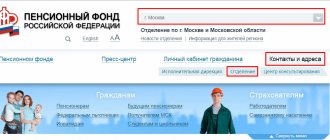Types of inspections and their periods
The Pension Fund of the Russian Federation, through its territorial divisions, conducts desk and on-site inspections of organizations (Article 33 of Law No. 212-FZ of July 24, 2009). In both cases, the goal is the same - to check whether contributions for pension and compulsory health insurance have been correctly calculated and paid. But the periods covered by such checks, as a rule, differ. You can quickly navigate all the timing and periods of on-site and desk inspections using the comparative table. If payments do not go to the Pension Fund, then read how to transfer money from a non-state pension fund.
As part of the desk audit, employees of the territorial office of the fund control only the period for which the organization compiled and submitted the calculation in accordance with the RSV-1 Pension Fund form (Part 1 of Article 34 of the Law of July 24, 2009 No. 212-FZ). For example, this is the calculation of the RSV-1 Pension Fund for the nine months of 2015. Then, as part of a desk audit of this calculation, the Pension Fund of the Russian Federation can check whether contributions have been calculated correctly only for these nine months. Although during the audit, fund employees can use information for other reporting periods.
But as part of an on-site inspection, fund employees have the right to check a period within three calendar years. Those that precede the year in which such an inspection was appointed (Part 9 of Article 35 of the Law of July 24, 2009 No. 212-FZ). And by the way, specific periods of the on-site inspection must be indicated in the decision to conduct it (clause 3, part 4, article 35 of the Law of July 24, 2009 No. 212-FZ).
General procedure for desk audit
The desk audit will begin from the day when the policyholder submitted a calculation to the Pension Fund of the Russian Federation in the RSV-1 Pension Fund form. Such an inspection may last three months from this date (Part 2 of Article 34 of the Law of July 24, 2009 No. 212-FZ).
When conducting a desk audit, fund employees are guided by Article 34 of the Law of July 24, 2009 No. 212-FZ and the Methodological Recommendations approved by the order of the Pension Fund Board of July 31, 2014 No. 323r.
A desk audit is carried out on the territory of the fund. Therefore, in addition to the calculation itself, fund employees can only use documents they already have during the inspection. Eg:
- calculations of insurance premiums presented earlier;
- documents that the policyholder submitted with the initial calculations - if we are talking about a desk audit of the updated calculation;
- extracts from accounting or tax registers;
- other documents received from the policyholder in the manner established by the Law of July 24, 2009 No. 212-FZ.
Fund employees have the right to request additional documents only if they identify any errors or contradictions in the submitted reports. In this case, they may require the organization to correct these nonconformities. And also has the right to request written or oral explanations.
Inspectors must inform the payer about any errors (inconsistencies) identified. At the same time, they will send a request to make corrections to the calculation. This requirement must be fulfilled within five working days. The period is counted from the day following the day when the organization received the demand via TKS or in person. If the request arrived by mail, then it is considered received on the sixth day from the date of dispatch, which is indicated in the stamp. Along with explanations, you can additionally submit documents to the fund that confirm the accuracy of the data. For example, extracts from accounting registers.
Such rules are established in parts 3–4 of Article 34 of the Law of July 24, 2009 No. 212-FZ.
In addition, during a desk audit, Pension Fund employees can call the payer of contributions to the territorial office of the fund to give oral explanations (clause 3, part 1, article 29 of the Law of July 24, 2009 No. 212-FZ). The call is issued in writing.
Situation: is it possible not to comply with the requirement of the Pension Fund of the Russian Federation to provide written explanations if this document does not indicate specific errors and (or) contradictions identified during a desk audit?
Yes, you can.
The Pension Fund of the Russian Federation has the right to demand written explanations from the organization only if there are errors and contradictions in the reporting. In this case, inspectors are obliged to inform the organization about specific identified inaccuracies and at the same time may require written explanations for them. This is stated in Part 3 of Article 34 of the Law of July 24, 2009 No. 212-FZ.
When there are no errors or contradictions, fund employees have no reason to demand an explanation from the policyholder. And if they nevertheless requested such without indicating specific errors and (or) contradictions, then this requirement may not be fulfilled. It is considered illegal.
Advice: It is still worth responding to the illegal request of the Pension Fund. Write that Pension Fund employees can demand clarification only if there are errors and contradictions in the calculation (Part 3 of Article 34 of Law No. 212-FZ of July 24, 2009). And since the received request does not say anything about errors, the request looks unreasonable and the organization cannot fulfill it.
Checking act
On the last day of the on-site inspection, inspectors are required to draw up a certificate of the inspection performed in Form 12-PFR (Appendix No. 18 to Order No. 957n). The certificate records the subject of the inspection and the timing of its implementation. The certificate is drawn up in two copies, one of which is given to the organization. If the policyholder evades receiving the certificate, it is sent to the payer of insurance premiums by registered mail and is considered received after six days from the date of sending the registered letter. Within two months from the date of drawing up the certificate of the on-site inspection, an inspection report must be drawn up in Form 17-PFR (Appendix No. 26 to Order No. 957n). The requirements for drawing up an on-site inspection report are set out in Appendix No. 28 to Order No. 957n of the Ministry of Health and Social Development of Russia. The on-site inspection report should not reflect non-payment of current payments. For such payments, a certificate of identification of arrears from the organization is drawn up in Form 3-PFR (Appendix 5 to Order No. 957n). The on-site inspection report must consist of three parts: introductory, descriptive and final. The introductory part of the act provides general information about the inspection carried out and the insurance premium payer being inspected. The descriptive part reflects information on the main issues subject to verification, including information about the identified: - underestimation of the base for calculating insurance premiums; - the amount of insurance premiums not paid as a result of understating the base for calculating insurance premiums; — non-payment (incomplete payment) of insurance premiums as a result of other unlawful actions (inaction); - failure to submit calculations for accrued and paid insurance premiums within the prescribed period, - as well as other documented facts of violations of the legislation of the Russian Federation on insurance premiums. As evidence, the on-site inspection report must be accompanied by certified copies of documents confirming the violations found. If no violations were identified during the on-site inspection, the on-site inspection report also describes all verified issues and the inspectors’ conclusions about the absence of violations and discrepancies regarding the correctness of calculation, completeness and timeliness of payment of insurance premiums. The final part of the on-site inspection report must contain: - conclusions on the collection from the policyholder of the amount of unpaid insurance premiums and penalties for their non-payment (late payment); — proposals to make the necessary corrections to accounting documents and other proposals to eliminate identified violations; — proposals to bring the organization to justice, outlining the grounds and elements of the offenses; — an indication of the right of the payer of insurance premiums to submit written objections to the on-site inspection report as a whole or to its individual provisions within 15 working days from the date of receipt of the inspection report. In addition, the report reflects the results of checking the timeliness and completeness of the insured’s submission of individual (personalized) accounting information. The inspection report is signed by the persons who conducted the on-site inspection and the person in respect of whom this inspection was carried out (his authorized representative). A corresponding entry is made in the inspection report regarding the refusal of the person in respect of whom the inspection was carried out (his authorized representative) to sign the act. Within five days from the date of signing, the inspection report must be delivered to the policyholder against signature or transferred in another way indicating the date of its receipt. If you evade receiving an inspection report, this fact is reflected in the inspection report. In this case, the act is sent by registered mail to the location of the organization (separate unit). In this case, the date of delivery of the act is considered to be the sixth day from the date of sending the registered letter. If you disagree with the facts set out in the inspection report, as well as with the conclusions and proposals of the inspectors, the policyholder, within 15 working days from the date of receipt of the inspection report, has the right to submit written objections to pensioners regarding the specified act as a whole or on its individual provisions (clause 5 of Article 38 Law N 212-FZ). At the same time, documents (certified copies thereof) confirming the validity of his objections may be attached to his written objections (or submitted within the agreed period) (clause 9.2 of the Methodological Recommendations). If there are no violations, this is indicated in the on-site inspection report and in the memo addressed to the head (deputy head) of the territorial office of the Pension Fund of the Russian Federation who made the decision to conduct this inspection. In this case, no decision is made based on the results of the on-site inspection (clause 9.3 of the Methodological Recommendations).
General procedure for on-site inspection
On-site inspections are carried out by fund employees, guided by Article 35 of Law No. 212-FZ dated July 24, 2009 and Methodological Recommendations approved by Order of the Board of the Pension Fund of the Russian Federation dated February 3, 2011 No. 34r.
Such a control event usually takes place on the territory of the contribution payer (i.e., the employing organization). But there is an exception. If the policyholder does not have the opportunity to provide premises for the inspection, then it will be carried out at the territorial office of the Pension Fund of Russia. This is stated in Part 1 of Article 35 of the Law of July 24, 2009 No. 212-FZ.
An on-site inspection begins with Pension Fund employees presenting the contribution payer with a decision to conduct an inspection. Such a document must indicate the composition of the inspectors and the period under inspection, which cannot be more than three years (Parts 4–9 of Article 35 of the Law of July 24, 2009 No. 212-FZ). Make sure that the inspectors have such a decision in their hands. And check your service IDs along with it. If they do not have such documents, then you have the right not to allow them to enter the organization’s territory for inspection.
You must familiarize yourself with the presented decision and put your signature. After this, the Pension Fund employee will present a request for the presentation of documents. By the way, if the inspection is carried out jointly with the Federal Social Insurance Fund of Russia, then each fund must have its own requirement. And these requirements will have to be fulfilled separately, independently of one another. That is, the documents will need to be prepared in two copies.
The on-site inspection ends on the day when the fund’s employees draw up a certificate confirming its conduct. In total, the on-site inspection cannot last longer than two months (Parts 11, 14, Article 35 of the Law of July 24, 2009 No. 212-FZ).
In some cases, the inspection period can be extended to four months, and in exceptional cases - to six months (Part 11, Article 35 of the Law of July 24, 2009 No. 212-FZ).
The basis for extending the on-site inspection to four and (or) six months may be:
- obtaining during the inspection information that indicates the presence of violations of the legislation on insurance premiums in the organization and requires additional verification;
- force majeure circumstances in the territory where the inspection is carried out;
- the presence of four or more separate divisions within the audited organization;
- failure to submit (untimely submission) by the organization of documents necessary for conducting an on-site inspection.
This is stated in Part 11.1 of Article 35 of the Law of July 24, 2009 No. 212-FZ.
To extend the period of an on-site inspection, the PFR branch that conducts it must send a reasoned request to the higher authority of the fund. Based on this request, the head (his deputy) of the higher authority will decide to extend the on-site inspection or refuse such an extension.
This procedure is provided for in Part 11.2 of Article 35 of the Law of July 24, 2009 No. 212-FZ.
Carrying out an inspection
As part of the on-site inspection, a period not exceeding three calendar years preceding the calendar year in which the decision to conduct the on-site inspection was made. The inspection in question is carried out by the Pension Fund of Russia branch no more than once every three years (clauses 9, 10, Article 35 of Law No. 212-FZ). The duration of the on-site inspection of the insurance premium payer is determined by the head (deputy head) of the territorial body of the Pension Fund of Russia (clause 2.2.4 of the Methodological Recommendations). But it cannot last more than two months if control measures of the organization are carried out, and one month when checking separate units (clauses 11, 13 of Article 35 of Law No. 212-FZ). This period is calculated from the day the decision to order an inspection is made and until the day a certificate of the inspection is drawn up. The head (deputy head) of the territorial branch of the Pension Fund of Russia has the right to suspend an on-site inspection only on the following grounds (clause 15 of Article 35 of Law No. 212-FZ): - to request documents (information) related to the subject of the inspection, in accordance with Art. 37 Law No. 212-FZ; — obtaining information from foreign government bodies within the framework of international treaties of the Russian Federation; — translation into Russian of documents submitted by the payer of insurance premiums in a foreign language. Suspension of an on-site inspection to request documents (information) is allowed no more than once for each person from whom documents are requested. The suspension and resumption of the inspection is formalized by the appropriate decision of the head (deputy head) of the Pension Fund of Russia department according to forms 10 and 11 (Appendices NN 16 and 17 to Order No. 957n). During the period of suspension of the inspection (clause 6.1 of the Methodological Recommendations): - all original documents required during the inspection are returned to the policyholder; - inspectors suspend their actions on the territory of the organization.
Types of on-site inspections
There are two types of on-site inspections: scheduled and unscheduled.
The territorial branches of the Pension Fund of Russia can carry out scheduled on-site inspections only together with the territorial branches of the FSS of Russia. The schedule of such inspections for each reporting period can be found on the portal of your regional branch of the FSS of Russia. Please note that this schedule is subject to change.
Unscheduled on-site inspections are carried out only in certain cases. For example, during liquidation or reorganization of an organization. This was stated in the letter of the Ministry of Health and Social Development of Russia dated February 22, 2011 No. 19-5/10/2-1748. Unscheduled inspections can be carried out by both the Pension Fund of Russia and the Federal Social Insurance Fund of Russia separately.
By the way, in addition to fund employees, tax inspectors can also take part in joint audits. They are involved to check the validity of the application of reduced insurance premium rates if the organization:
- carries out activities in the field of information technology;
- provides engineering services.
This procedure is established by paragraph 2 of part 5 of article 33 of the Law of July 24, 2009 No. 212-FZ.
Joint audits of funds and tax authorities
Participation in a joint audit of tax authorities does not entail the risk of additional taxes. However, they may receive certain information during the audit and then consider conducting an on-site tax audit of this company.
As part of control activities, the FSS and the Pension Fund have the right to conduct desk and on-site inspections of insurance premium payers.
The standards for carrying out these control activities are generally similar to the rules that tax officials must follow during on-site and desk audits (Article 87 of the Tax Code of the Russian Federation).
However, they are less detailed and, as a result, raise many questions for companies. This article from the journal “Actual Accounting” No. 8, 2012 examines the question of what controllers have the right to do during joint inspections.
Tax officials, at the request of the Pension Fund or Social Insurance Fund, in order to verify the justified application of reduced insurance premium rates, have the right to participate together with funds in on-site control activities.






